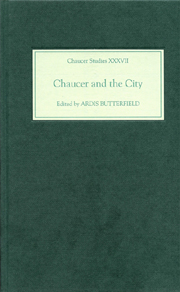Book contents
12 - Chaucer and the Nineteenth-Century City
from AFTERLIVES
Published online by Cambridge University Press: 05 February 2013
Summary
This essay argues that the warm acclaim the Victorians gave to Chaucer reflects to a significant extent the era's own anxious and conflicted responses to rapid urbanisation. And correspondingly, changes in the perception of Chaucer between 1800 and the Edwardians have parallels in changing attitudes to the city during that period.
The 1868 Westminster Abbey Chaucer Window chose only images from the Flower and the Leaf and General Prologue to represent Chaucer's genius (together with words from Truth), typifying the mid nineteenth century's, to many modern readers, extraordinary esteem for the (apocryphal) Flower and the Leaf, regarded as foremost among a group of poems that established Chaucer as a great Nature-poet. The two texts illustrated exemplify the period's dual construction of Chaucer as a poet of Nature and Human Nature, two sides of the era's concept of literary genius, with its tendency to see the acme of literary achievement as residing either in celebration of Nature or creation of character.
Admiration for the General Prologue's God's Plenty of human character was already established and would continue after the nineteenth century (the Prioress's Tale and Clerk's Tale were also prized for capturing human nature, especially in the form of pathos) but it is the image of Chaucer the Nature-poet that is distinctive to the century's central decades. Early in the century Chaucer's characteristics were generally seen, as in the eighteenth century, as social observation of human types, satire, and, for some still, a primitive lack of morality and literary polish: poetry of human nature and activity and the bustling social world not of solitary natural contemplation.
- Type
- Chapter
- Information
- Chaucer and the City , pp. 193 - 210Publisher: Boydell & BrewerPrint publication year: 2006

